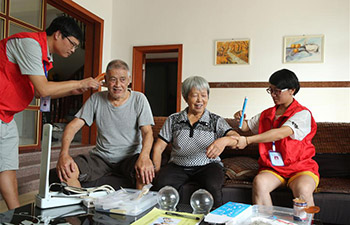CHICAGO, Aug. 17 (Xinhua) -- The frequency of brain tumors has been underestimated in children with the common genetic syndrome neurofibromatosis type 1 (NF1), characterized by birthmarks on the skin and benign nerve tumors that develop in or on the skin, according to a new study.
This study of brain scans performed on children with NF1 at Washington University School of Medicine in St. Louis found that the frequency of brain tumors in this population was more than three times higher.
Brain magnetic resonance imaging (MRI) scans of children with NF1 characteristically show bright spots that are absent in the scans of unaffected children. Since brain tumors can be confused with harmless bright spots, it has never been clear whether finding these abnormalities via MRI should be a cause for concern.
For the purpose, the researchers have developed a set of criteria to distinguish tumors from other bright spots, using features such as the location and shape of the bright spot, the sharpness of its border and whether the brain tissue surrounding the bright spot appears displaced or compressed.
Using these criteria, they studied brain scans from children with NF1 performed at the School of Medicine from 2006 to 2016. They analyzed scans from 68 NF1 patients as well as 46 children without NF1 for comparison.
As most of the children had undergone multiple scans, the researchers examined a total of 190 brain scans from NF1 patients and 104 scans from children without NF1.
All but four, or 94 percent of the children with NF1 had bright spots, and none of the children without NF1 did. Further, in 57 percent of the children with bright spots, at least one of the spots was deemed likely to be a tumor.
Then, 10 of the children whose bright spots were classified as probable tumors underwent brain biopsies as part of their medical care, and all 10 were proven to be brain tumors. Furthermore, 28 percent of these probable tumors eventually required treatment, providing further evidence that they had been correctly classified.
Applying the new criteria to MRI scans will help physicians identify probable tumors, but that does not mean that all children with NF1 should be scanned regularly, the researchers cautioned.
NF1 affects about one in every 3,000 people. It can affect almost any organ system, causing a wide variety of features including bone deformities, learning and attention deficits, autism, vision loss and cancer.
The findings have been published online in the journal Neurology: Clinical Practice.

















